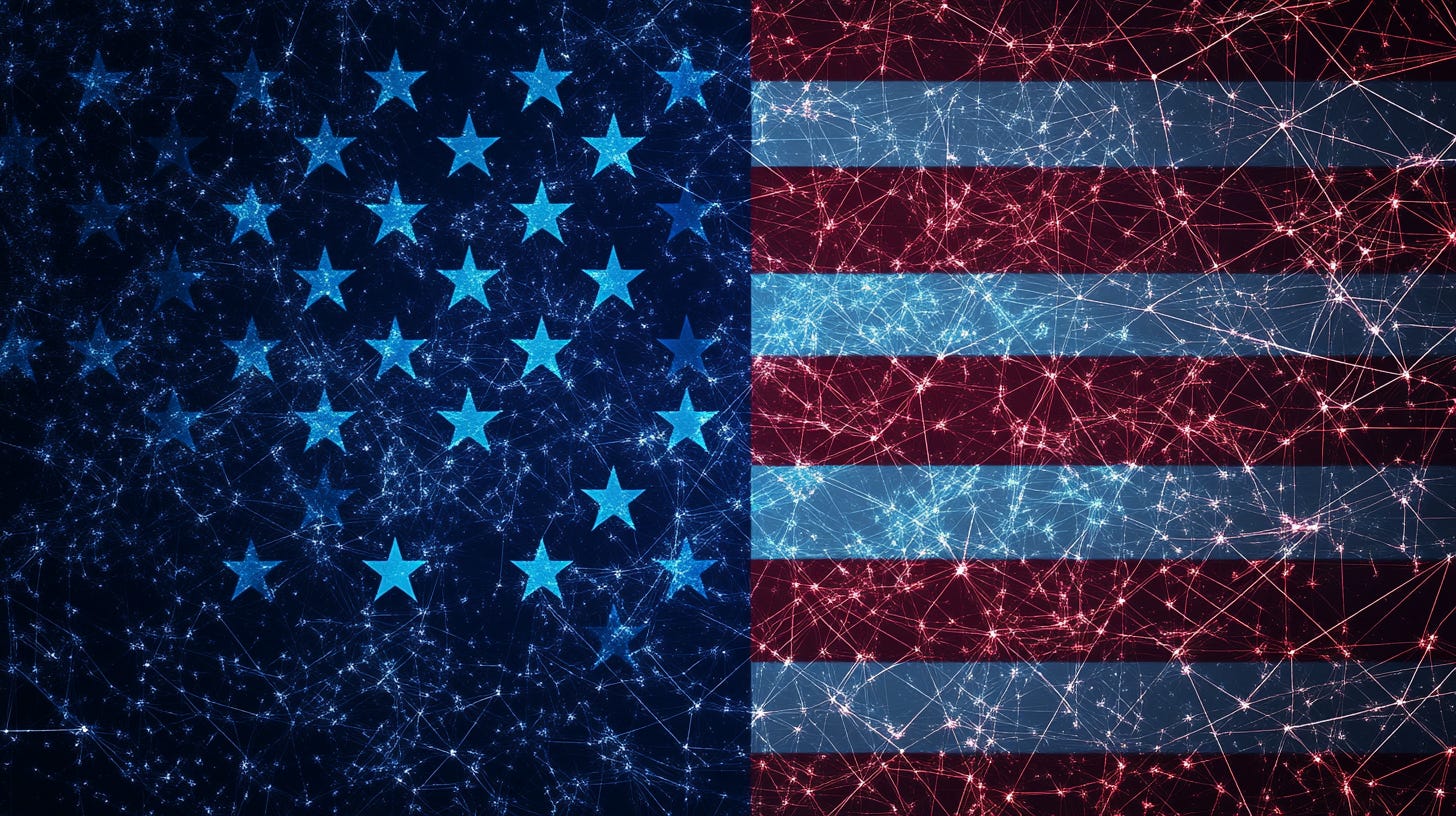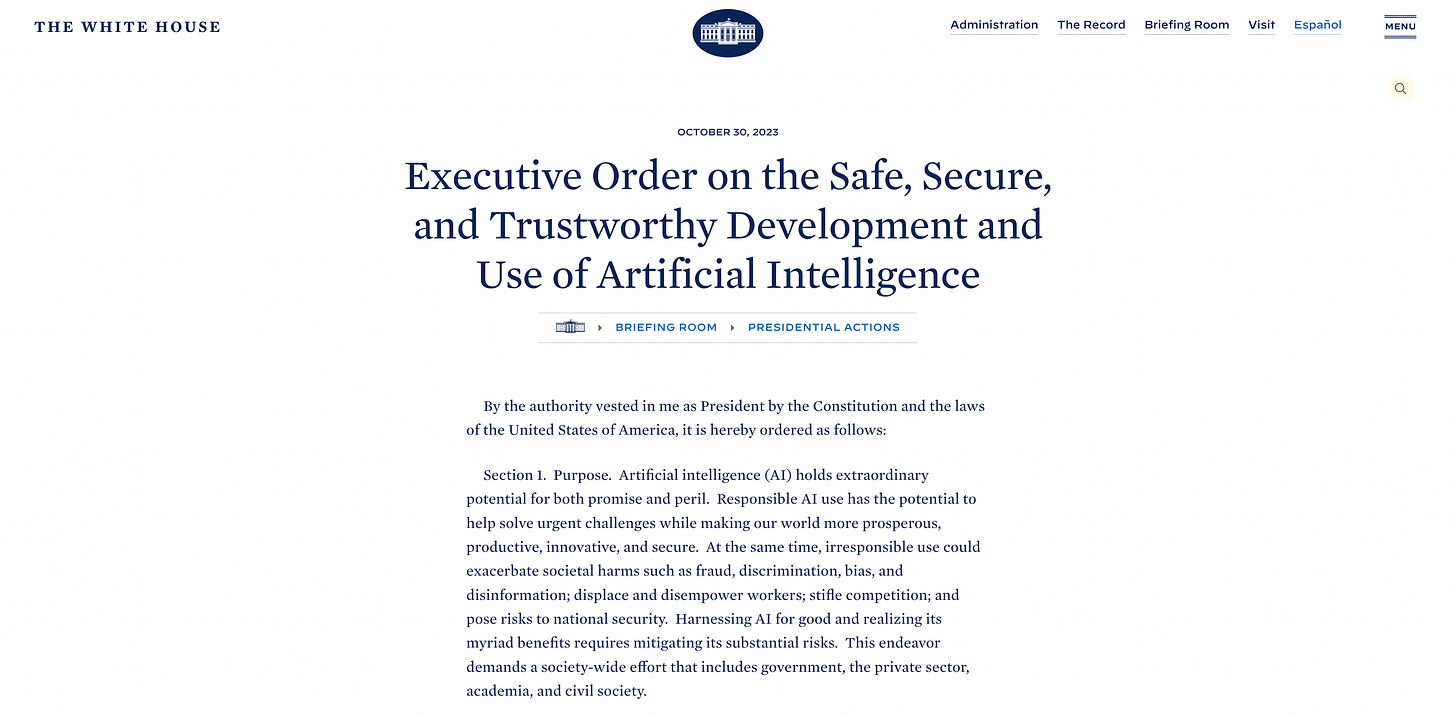Tonight, as election results stream in, America isn't just choosing a president – it's choosing the future of AI.
While pundits focus on exit polls and vote counts, you’re probably not going to see anything said about AI.
But these are two completely different philosophies that could reshape how AI evolves in America.
One path leads toward careful oversight and measured progress. The other accelerates toward maximum innovation. The direction we choose tonight will echo through every aspect of how AI shapes our future. (And yet, I think both candidates are incredibly unprepared for what is coming in AI.)
Both approaches carry significant potential and risks. A carefully regulated AI future could ensure safer development while almost certainly slowing innovation. A deregulated approach could accelerate breakthroughs but will undoubtedly overlook important safeguards. There's no perfect answer – but everyone needs to understand the tradeoffs.
Let’s take a look inside these two competing visions.
The careful hand: Harris's AI guardrails
At its core, Harris envisions AI as more than just a technology race – she sees it as a force that needs to be actively shaped to serve democratic values and public interest. Her approach reflects a fundamental belief that without proper guardrails, AI's transformative power could amplify existing societal challenges rather than solve them.
Let me break down exactly what this means:
Regulation and Safety: Harris isn't just talking about vague oversight – she's pushing for specific, measurable standards. Companies would need to meet concrete benchmarks for accuracy, reliability, and fairness before deployment. For facial recognition systems, this means proving accuracy across different demographics. For autonomous systems, it means extensive safety testing in real-world conditions. Every AI company would need to maintain detailed documentation of their training data and development processes, making it possible to trace and correct issues when they arise.
Federal Oversight: The details here are significant. Harris wants to empower the FTC with specific authority to investigate AI companies for deceptive practices around AI capabilities and risks. The DOJ would receive expanded powers to pursue cases of AI-enabled discrimination. Her proposed federal advisory board wouldn't simply make recommendations – it would help set binding standards for AI development and deployment, creating an FDA-like framework for AI systems.
Civil Rights and Ethics: Harris's approach demands concrete accountability. Mandatory audits would require companies to demonstrate their AI systems perform equally well across different racial, ethnic, and gender groups. Law enforcement AI would require public transparency reports showing accuracy rates and error patterns across demographics. Any AI system used for critical decisions in lending, housing, or employment would need to prove it doesn't perpetuate historical biases.
Innovation and Economic Growth: Harris envisions targeted investment in America's AI future. She's proposing new AI research centers focused specifically on public interest applications – climate change, healthcare, education. Her plan includes matching grants for startups working on responsible AI tools, particularly those addressing bias detection or privacy protection. This funding would prioritize diverse founders and researchers historically underrepresented in AI development.
Workforce Development: Harris proposes a systematic approach to the AI transition. Her plan includes industry-specific programs targeting workers most at risk of AI displacement, partnerships with community colleges for AI-focused technical training, and grants for businesses to upskill their existing workforce. This extends to K-12 education, with new AI literacy standards and funding for teacher training in AI concepts.
International Collaboration: Harris's global strategy is highly specific. She's proposing shared frameworks for AI safety testing across democratic nations, essentially creating an "AI NATO" to counter China's influence. This includes standardized model evaluation processes, coordinated research on AI risks, and joint investment in privacy-preserving AI technologies.
Trump's free-market vision
Trump's vision for AI represents a fundamentally different philosophy: American innovation thrives when government gets out of the way. His approach focuses on maximizing speed, market competition, and American technological dominance through dramatic reduction of regulatory barriers.
Let me break down the specifics:
Deregulation Strategy: Trump's plan is direct and comprehensive. He aims to dismantle current AI regulations, including the Biden administration's executive order, and eliminate mandatory testing requirements for AI systems. Companies would self-certify their AI systems' safety and effectiveness. The market would drive rapid iteration and improvement, with successful systems rising to the top through competition. This could dramatically accelerate the pace of AI development, reducing deployment timelines from months to days.
National Security and Defense: National security forms a cornerstone of Trump's AI strategy. He advocates for accelerated development of AI-powered military technologies with streamlined oversight. This includes autonomous defense systems, AI-enhanced cyber capabilities, and advanced threat detection tools. His proposed fast-track approval process for critical national security AI applications would significantly speed up military AI advancement. The plan also encompasses AI-powered border security and surveillance capabilities.
Private Sector Empowerment: The private sector takes center stage in Trump's vision. His plan includes substantial tax breaks for AI research and development, reduced liability provisions for AI companies, and expedited AI patent processes. A proposed "regulatory sandbox" would allow companies to test innovative AI applications with minimal restrictions. This framework could unleash unprecedented levels of private sector AI innovation and investment.
China Competition: Trump's approach to the AI race with China is aggressive and direct. His strategy combines expanded export controls on AI technology, restrictions on Chinese investment in U.S. AI companies, and targeted tax incentives for companies competing with Chinese AI firms. Fast-track approvals would be granted to AI applications that reduce dependence on Chinese technology. This focused competitive strategy aims to maintain American technological supremacy.
Data and Privacy Approach: Trump advocates for a streamlined privacy framework centered on national security priorities. Companies would maintain significant flexibility in data collection and usage for AI development, with basic requirements around data security and foreign access restrictions. This could enable faster training of AI models and more rapid technological advancement.
Workforce and Education: Trump's workforce strategy relies on market dynamics and private sector initiative. His plan incentivizes companies to provide AI training through tax benefits, allowing industries to naturally adapt to technological change. This approach favors organic market evolution over government-directed transitions, potentially allowing for more flexible and industry-specific adaptation.
International Strategy: Trump's international approach prioritizes focused partnerships over broad collaboration. His proposed "AI alliance" would concentrate specifically on countering China's AI advancement, sharing military AI capabilities with select allies while maintaining strong U.S. autonomy. This selective cooperation strategy aims to build a focused coalition while preserving American technological independence.
A clear-eyed view of the road ahead
After breaking down these competing visions for American AI, I'll be honest: neither fully addresses the unprecedented transformation we're about to experience.
While both candidates present distinct approaches to AI governance, they're still operating from traditional political playbooks that aren't equipped for the reality we're facing. The next four years will likely see AI advances that will fundamentally reshape our society in ways that our current governmental and economic systems simply aren't prepared to handle.
Think about it: we need to reimagine education from the ground up, not just add AI literacy programs. We need to completely rethink worker protections and social safety nets, not just create retraining programs. Our regulatory bodies, legal frameworks, and economic policies were built for a different era entirely. Neither a hands-off market approach nor traditional regulatory oversight will be sufficient for managing the profound changes ahead.
What we really need is a ground-up reimagining of how our society functions in an age of transformative AI. This means new types of institutions, new frameworks for managing technological change, and new ways of thinking about everything from education to economic safety nets to national security. Whether Harris or Trump wins tonight, the real work of preparing America for the AI age still lies ahead.
The truth is, the AI revolution won't wait for our political system to catch up. As you read these election results tonight, remember: this is just the beginning of a much longer and more fundamental conversation about how we adapt our society for the unprecedented changes ahead.






